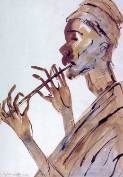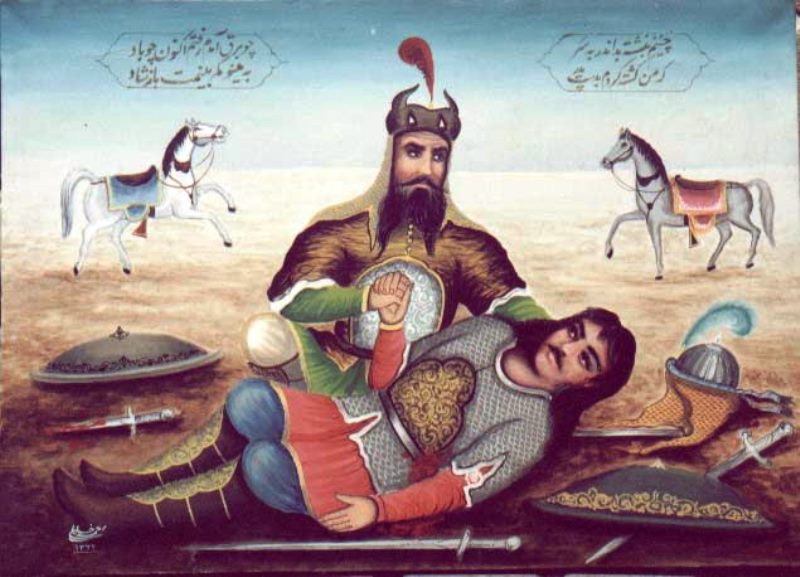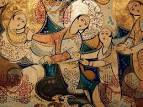-
Paper Information
- Paper Submission
-
Journal Information
- About This Journal
- Editorial Board
- Current Issue
- Archive
- Author Guidelines
- Contact Us
International Journal of Arts
p-ISSN: 2168-4995 e-ISSN: 2168-5002
2018; 8(3): 53-59
doi:10.5923/j.arts.20180803.02

Investigation of Modern Aspects in Painting of Iranian Contemporary Artists
Ashraf Bagheri Poor
Department of Islamic Art and Humanities, Imam Reza International University, Mashhad, Iran
Correspondence to: Ashraf Bagheri Poor, Department of Islamic Art and Humanities, Imam Reza International University, Mashhad, Iran.
| Email: |  |
Copyright © 2018 The Author(s). Published by Scientific & Academic Publishing.
This work is licensed under the Creative Commons Attribution International License (CC BY).
http://creativecommons.org/licenses/by/4.0/

Modern arts are masterpieces which emerged in 2nd half of 19th century in Europe and USA. Such modern works and schools caused changes in visual arts, especially painting from 40 decade afterwards in Iran [1]. The present study aims to express the history and formation factors of art modernism in Iran and also to search for the reasons of defeat of Iranian painters in this style and to put forward some suggestions to attract addressees and visitors in this realm. We collected data form libraries and our method is analytic- descriptive way. Our findings show that being unaware of cultural and social changes plus ignorance of using traditional religious and national codes and elements and lack of theoretical bases for art work creation and little knowledge about formation of modern art styles in West are completely among factors that made Iranian contemporary painting unstable and contentless.
Keywords: Iran Contemporary Painting, Modern Painting, National Art, Modern Painting Pioneers
Cite this paper: Ashraf Bagheri Poor, Investigation of Modern Aspects in Painting of Iranian Contemporary Artists, International Journal of Arts, Vol. 8 No. 3, 2018, pp. 53-59. doi: 10.5923/j.arts.20180803.02.
Article Outline
1. Introduction
- Almost 70 years after commence of art modernism movement in West, this art style formed in Iran. Extending the 2nd world war and cultural changes related to arrival of the Alies to Iran (1941), caused an opportunity for art modernism. The most important development in art modernism can be taken into account by social changes due to cultural and political activities of Reza Shah Pahlavi [2].Examination of trend of modern painting in Iran revealed that development in this area can be divided into two phases: before Kamal Al-Molk (1848-1940) and afterwards. In Qajar era artists like Mahmod khan Malekoshara (1849-1932) and Abolhassan Ghafari (1850-1904) could create works independent of their traditional method, which if continued could establish a new painting school [3]. With emergence of Kamal Almolk, classic European painting was introduced instead of traditional and national painting. Imitating European artists like Rambrand (1606-1669) and Tisin (1487-1576), he trained in new established school of art, students which developed nature-based painting like naturalism style and realistic style [3]. By foundation of fine art faculty of university of Tehran (1940) by Andre Godard (1881-1965) Iranist scholar, kamal Almolk school declined. Teaching of French instructors in the faculty acquainted the students with various painting schools and styles like Impressionism, Cubism, Expressionism and…, Such development formed a return point in art modernism in Iran [3].
2. Literature Review
- Despite other art courses which formed outside of academic system art of painting grew because of art training in universities. Although these university bases had not a consistent training program and their existence owed to imitation of Paris art schools, but this matter could not cause blockage of Iranian art creation and talent [4]. Art modernism were always criticized by the critics, because such kind of arts was not accepted by Iranian community [4], many researchers tried to investigate the causes of the issue. Amongst the last investigations conducted in this area, we may mention: “study of painting modernism in Iran”, written by Mahtab Mobini and Maryam Firozbakhat (2015), the authors tried to realize the trend of development of Iranian modern painting and to elicit the causes of their defeat. Another study done by Razieh Keshvari and Behnam Jalali (2016) titled “criticism on formation of modern painting in Iranian contemporary art”, in this study the writers struggled to compare traditional painting with modern painting art. Sid Rassol Mareknezhad (2013) is another researcher whose study titled “Modern art pioneers in Iran” tries to firstly introduce outstanding artists of the painting style in Iran and finally stated reception of art modernism results from many factors including cultural and political changes of that era. The present study aims to investigate the history of painting modernism in Iran briefly, then formation agents and characteristic of it and finally points to overcome the painting stagnation as well.
3. Modernism Factors in Iran Painting Art
- In years after constitution revolution, weakness of the king of Qajar, division of Iran between Russia and England, lack of a powerful parliament and continuous and spreading revolts in different parts of the country attenuated political system [5]. The 1st world war (1914-1918) occurred during the governorship of the last Qajar king (Ahmad shah). After the end of war, many Iranian intellectuals resided in Germany, such as side Hassan Taghizadeh, established “Iran-Germany” association. Foundation of the association played a key role to encourage young people to imitate western culture [5]. Reza Shah became a king after coup d’etat (21 feb 1921). He was after European civilization and tried to change the Iranian society [5]. He planned to dispatch Iranian students to Germany and France, but this activities were on the surface and the students imitated west outwards rather than deep recognition of West [5]. Blazing the flame of 2nd world war (1939-1945), Reza Shah resigned from monarchy at 15 September (1941). His son Mohammad Reza Pahlavi became the king [5]. Such political changes, caused Iran to be imposed by different beliefs and ideologies. Intellectuals searched for new ways eagerly [5]. Many believed that following western culture and art was necessary to compensate retardation, thus they created art works and founded European- styled art & culture Centers, including Tehran university (1934), Iran Culture Academy (1935), Ancient Iran Museum (1936), Iran National Library in Tehran (1937), Pars Museum in Shiraz (1938) [6].Acceleration to connecting to modern world, in visual arts realm, increased when kamal Almolk died (1940), and fine arts faculty of Tehran was established by Andre Godard. The faculty curriculum and teaching style was according to Paris fine arts school (beaux Arts) and painting school of Impressionism and post-Impressionism were taught [6]. The first group of art students were sent to Europe to get familiar with modern art works. They propagated their understanding of modern art in return. Acquaintance of modern art works caused thinking of getting rid of traditional bonds amongst new generation painters. The first challenge between traditional painters (kamal Almolk art school) and modern painters commenced in art meetings [6]. The dispatched students were attracted by Cubism and Expressionism. Being influenced by western art was just in form and technique not in content and matter and thought [6]. Therefore, form and technique of painting were western, but in content, Iranian art subjectivism was dominant.
4. The Pioneers of Modern Painting Art of Iran
- In 20th decade, the modern artists created work which had no precedence in Iranian memory and made the society astonished [7]. These artists tried to built a space by doing speeches and publishing books and articles, to make their art understand able by people. We can mention following artists:1- Jalil Ziapour (1920-1999), he went to France after graduation from fine arts faculty and got familiar with Cubism school of painting. He tried to coordinate Cubism and Iranian painting, to achieve this goal, he selected tile square geometry as his growing composition cell, and local arts. Moreover, his interest in country and gypsy life caused the appearance of country themes in his works symbolically [8] (fig 1,2).
 | Figure 1. Lor girl, Jalil ziapour |
 | Figure 2. The world inside, Jalil ziapour |
 | Figure 3. Painting of Ahmad Esfandiari |
 | Figure 4. Painting of Abdullah Ameri |
 | Figure 5. Painting of Abdullah Ameri |
5. Second Generation of Modern Artists
- 1st generation of modern artists in Iran contemporary painters, showed propensity to impressionism plus Cubism. Iranian impressionist works have attracted more visitors than other painting schools, because of choosing themes with close relationships to daily life of people realistically. Modern wave in 2nd generation painters increased because of some factors including group exhibitions, painting and sculpture biennial exhibitions and establishment of painting galleries [9]. Amongst most important artists in that period are:1- Hossin Kazemi (1924-1996), he went to Europe after graduation from Tehran fine art faculty and exhibited his works in Reza Abassi gallery. His works have propensity to abstraction and brevity; using two elements: stone and plant, on mono-color background and also using element of texture to induce opposition forces the visitors to watch a variety of heterogeneous spectrum of emotions and eventually guides them to a mystical sphere beyond his tableaus where all elements become unite [10].The first works of Kazemi were illustrations of realistic impressionism style, gradually faced to pure abstraction and finally in succession to define a kind of balanced harmony between angular drawing and dynamic calligraphic lines. The theme of contradiction and sameness of opposite agents in his last semi-abstraction painting with agents such as stone and plant, represented vividly [10] (fig 6,7).
 | Figure 6. Painting of Hossin Kazemi |
 | Figure 7. Painting of Hossin Kazemi |
 | Figure 8. Painting of Hoshang pezeshk nia |
 | Figure 9. Painting of Hoshang Pezeshknia |
 | Figure 10. Painting of Bahman Mohases |
 | Figure 11. Painting of Bahman Mohases |
 | Figure 12. Painting of Behjat Sadr |
6. Tea-House Painting School
- Tea-house or coffee-house painting is an idiom to name a type of painting which has the technique of color and oil and its subject is about religious or epic matters, and in constitution revolution influenced by nature based painting, was painted by untaught artists. Many references dated back this kind of painting to Safavid era and name Shiatt spreading as its propagate reason, but studies show that this type of painting related to Qajar era. In that period, Iran was in tension with Osmanid, and great religious motives were needed to resist against that enemy. Thus, painting on large canvas named “portrait “were installed in bazars and streets. The first orders for this type of Portrait were by coffee-house- owners, who paid very little to the artists. Coffee/tea- house was a place where all people from many social classes gathered. Art style or school was not important for owners of such places, they just pay attention to story tellers in their tea-house. Thus, coffee/tea house became locations to boost nationality and religious motives. [13]
 | Figure 13. Painting of Iran Dorodi |
 | Figure 14. Tea- House Painting school |
 | Figure 15. Rostam & Sohrab, Tea- House Painting School |
7. Public- Drinking Painting School
- Public- drinking were places in bazars with crowded streets to remember Karbala epic. The walls of public –drinking are covered by pictures of Karbala epic. This phrase (public- drinking painting) was used by Karim Imami (1930-1969), who was visual art critic, to name a kind of modern painting for first time. The first works were illustrated by Hossin Zandehrodi [14], using various calligraphy lines, carpet and tile decoration elements and peasant designs, gradually encouraged artists to face this painting school. Amongst follower of this school, we can name Hossin Zendehrodi, Masoud Arabshahi and Mansor Ghandriz. Such painters used symbols and codes of Karbala epic in their tableaus and tried to connect popular religious art with modern global art and traditional and local art [14]. In other words, they wanted to open a way toward local art by aesthetic adaptation of modern abstract art on Iranian- Islamic functionalism. Therefore, the issue of establishment a national Iranian art school presented in that period of time.
 | Figure 16. Public- Drinking Painting School |
8. Criticism of Iranian Contemporary Painting
- Iranian contemporary modern painting should be criticized. The word “modernism” is used in many periods and places. To discriminate contemporary methods from traditional ways and it worth noting, that it can be applied to any area of life. From 17th century, in which the word “modern temples” was used, there was a distinction between modern history and Medieval [15]. Meanwhile other sources regarded the commence of modernism, the end of 15th century and early 16th century [15]. The word “renaissance” is an equivalency of “ modernism” to describe human being societies or civilizations. This concept means motion toward development of thought. Technology and life style, is a western concept in its essence. The word “renaissance” is usually used vs the word “tradition”, but the truth is that two concepts are not contradictory, and both has an elegant connection. Tradition is a set of special historic, cultural and religious elements but “traditionalism” is a kind of ideology and particular understanding of existence, human being and their relations ships [15]. Many authors believed that all changes in economic, cultural, social and political issues are presentation of modernism. This term is used ambiguously, and can be applied to culture or philosophy or to a historic movement in art during (1850-1950). We witnessed particular experiences in art, in painting, a realistic school of Gustav Corbe, in Clode Moneh impressionism, to abstract expressionism of Jakson polka, in music, unbalanced sounds of Arnold Shoninberg and Alban Parg, to matterless structure, of Igor Stravinski; in architecture, the Modernism of loco Bozieh, Lodvic Misvan and Valter Grobios, but what makes modernism, modernism, is not industries and technology and high level life, but is human mind (individualism) that is latent in the concept. A positive face which show western modern culture, is the picture of civilization based on scientific knowledge of the world and rational knowledge of human being [16]. This civilization has the greatest right for human individual liberties, and believed that such freedom and rationality will result in social improvement; the signs of such improvement are virtue, creative thinking and prosperity [16]. In criticism of modernism, it should be noted that this approach in art has high position, and their bases and grounds are totally developed, but it has not such position in Iran. Individualism in the West has passed a distinct path which its consequences are emerged in 20th century, but in Iran, there was no proportional ground of individualism, and the main reason is opposed ideology of Iranian artists. We can conclude from what have been said so far, that such phenomenon is an imported matter to Iran and Iranian culture, and because it has no root in Iranian history, it converted to “tea- house” or “public-drinking” painting school [17].
9. Conclusions
- Modern art movement kept distance from content gradually, and defined work on technique as their ultimate goal. In modern art, beauty is no longer a necessary factor for an art work and there is no evident of it in many modern and post-modern works [17]. Modernism in Iran painting is pure imitation of western modern art style, kept distance from social and cultural necessity and from art aesthetic concept as well, and faced to ambiguity, brevity and abstraction [17]. Iranian modern painting exited its cultural background rapidly and purely imitated European art works, this matter caused getting for from their society realities and consequently its existence endangered. The main aim of this age artists was acceptance in global bazar rather than visitors in Iran [18]. Modern painting in Iran was more commanded by government rather than avant-gardism. The artist is not just, an art work creator, but is an agent to awakening religious and cultural emotions. He can not aware community, unless he can aware himself [19]. If modern painters created works according to national identity or even personality their influence on the visitors and their preservation increasing accordingly [19]. Innovation was a factor ignored by Iranian modern artists. The motive and goal of modern artists was being admired by others, this matter weekend their works, and made them dispersed. The Iranian modern artists did not obtain an independent art movement [20]. Because of above mentioned issues, modern painting could not provide a reliable rich backing for revolutionary artists who were seeking identity and art independence after Islamic revolution in Iran, thus, painting declined in contemporary age in Iran.
Notes
- 1. A kind of adornment and decoration on tile, wood etc.2 and 3. two famous painting schools, which their names are taken from the locations they assigned to
 Abstract
Abstract Reference
Reference Full-Text PDF
Full-Text PDF Full-text HTML
Full-text HTML